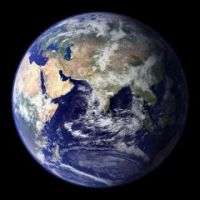March 16, 2012 report
Study of isotopes shows recycling of Earth’s crust began 3 billion years ago

(PhysOrg.com) -- New research by a team of British Earth scientists shows that while the Earth’s crust was made up of new material for much of its early life, it later began to recycle material three billion years ago, leading to the development of the continents we know today. The research team came to this conclusion, as they report in their paper published in Science, after studying oxygen isotopes in zircon samples taken from several different points across the globe.
To try to find out what has been going on with the Earth’s crust as far back in time as possible, the team took sediment samples from North and South America, Eurasia and Australia. They focused their studies on oxygen isotopes found in zircon in those samples reasoning that newer crust material would more closely resemble material found in the mantle, as external factors on the surface of the planet would impact those that have been exposed to the sun, erosion and other biologic entities.
Because the ratio of oxygen-18 to oxygen-16 found in the crust is generally a narrow range and the oxygen-18 to oxygen-16 ratio on the surface is more broad, researchers can compare materials on the surface against those in the mantel to gauge how long those in the crust have been there, which in turn allows them to determine whether material in the crust is new, or has simply been recycled from below. By taking very precise measurements, the team was able to create an accurate time line of how material on the surface was formed.
Specifically, they found that during the first billion and a half years of Earth’s existence, the rate of new crust formation was quite high (presumably due to meteorite collisions), at about 3 cubic kilometers annually which resulted in the creation of roughly sixty five percent of its current composition. About three billion years ago, however, smaller amounts of new material were created and more of the crust was simply recycled with material from the mantle.
As a result of this change, the tectonic plates we see today began forming, growing ever more solid as the years passed, leading to the shifting that causes changes to the shape and location of the continents.
The team next plans to explore the tectonic changes that occurred prior to three billion years ago, but acknowledge it will be difficult due to the dearth of rocks older than that lying on or near the planet’s surface.
More information: A Change in the Geodynamics of Continental Growth 3 Billion Years Ago, Science 16 March 2012: Vol. 335 no. 6074 pp. 1334-1336. DOI:10.1126/science.1216066
ABSTRACT
Models for the growth of continental crust rely on knowing the balance between the generation of new crust and the reworking of old crust throughout Earth’s history. The oxygen isotopic composition of zircons, for which uranium-lead and hafnium isotopic data provide age constraints, is a key archive of crustal reworking. We identified systematic variations in hafnium and oxygen isotopes in zircons of different ages that reveal the relative proportions of reworked crust and of new crust through time. Growth of continental crust appears to have been a continuous process, albeit at variable rates. A marked decrease in the rate of crustal growth at ~3 billion years ago may be linked to the onset of subduction-driven plate tectonics.
© 2011 PhysOrg.com

















